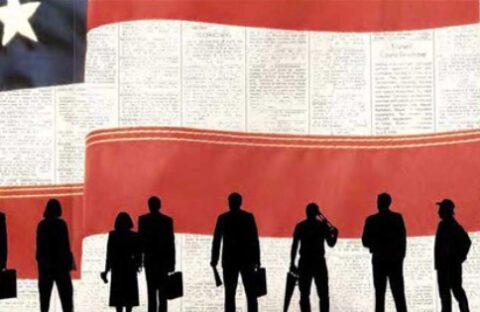Employment and Wages

Immigration and the Future of American Innovation: Does America Need to Pump Up the Volume?
It should come as no surprise to anyone following the global economy that when it comes to innovation and competition, America has lost that loving feeling. Numbers in key areas of innovation—percentage of patents issued, government funded research and venture capitalists' investments—are all down. While some point a finger at a weaker economy, others look to poor domestic policy and increased global competition. Either way, American innovation is slowly fading on the global stage. Read More

Nativist Group Blames Immigrants for Unemployment and Low Wages
The Federation for American Immigration Reform (FAIR) yesterday released a report, Amnesty and the American Worker, which recycles a number of discredited claims about the supposedly negative impact that immigrants have on U.S. workers and the U.S. economy. According to FAIR, unauthorized immigration has “put Americans out of work and reduced wage levels for all workers across broad sectors of the economy.” The FAIR report also claims that granting legal status to currently unauthorized immigrants would be a drain on the U.S. economy because newly legalized immigrants would qualify for tax credits. FAIR ignores the fact that there is no correlation between immigration and unemployment in the United States—that immigration has provided a small wage boost to most native-born workers and helped “grow” the economy—and that newly legalized immigrants would earn higher wages and therefore spend more in U.S. businesses and pay more in all kinds of taxes. Read More

Restrictionist Group Strikes Back
Today, the Center for Immigration Studies (CIS) released a report which attacks the decision of the Southern Poverty Law Center (SPLC) to designate the Federation for American Immigration Reform (FAIR) a “hate group,” and thereby impugn the reputation of two FAIR spin-offs: CIS and NumbersUSA. The report offers a defense of FAIR and its founder, John Tanton (a man who has expressed sympathy for eugenics—that is, selective human breeding), and attacks SPLC and its work with the National Council of La Raza (NCLR) and other organizations belonging to the “Stop the Hate” campaign. Leaving aside SPLC’s rebuttal of the report, or the question raised by the report of why it took so long for FAIR’s (hateful) past to catch up with it, the fact remains that FAIR, CIS, and NumbersUSA have engaged in an intellectually dishonest analysis of immigration that sometimes devolves into name-calling. Read More

Budgeting Immigration: Secretary Napolitano Talks Dollars and Programming
Department of Homeland Security (DHS) Secretary Janet Napolitano spent the past two days testifying in front of congressional committees addressing concerns over President Obama’s fiscal year (FY) 2011 DHS budget. Mixed in among the complaints over proposed cuts in cyber security and the Coast Guard were a number of budget decisions with immigration implications. Chief among those decisions were a cut in border patrol agents, the status of the troubled SBInet program, and worksite enforcement efforts—including the oft-maligned E-Verify program. Read More

E-Verify Gets It Wrong, Again
Another independent evaluation of the E-Verify program once again confirms what advocates have been saying for years—E-Verify doesn’t work. A new evaluation of the federal employment authorization program—conducted by Westat, a research company, in December 2009—is now available on the E-Verify website. The system only detected unauthorized workers about half of the time. The evaluation found the program couldn't confirm whether the documents workers were presenting were their own. As a result, "many unauthorized workers obtain employment by committing identity fraud that cannot be detected by E-Verify," according to Westat. The "inaccuracy rate for unauthorized workers" is about 54%. Read More

Can Immigrants Give America’s Rust Belt a Tune-Up?
Immigrants have long been a driving economic force in America’s large thriving metropolitan areas—New York, Los Angeles, Chicago, Miami, Dallas—where immigrants’ economic output produces a large and growing share of the U.S. gross domestic product. But what about the once thriving industrial heartland of the United States known as the Rust Belt? In a roundtable discussion yesterday in Akron, Ohio, authors Richard Herman and Robert Smith discussed their new book which points out how “immigrants and the businesses they create” can “provide rundown neighborhoods with a powerful jolt of new investment and spinoff job opportunities” and how our broken immigration system is taking away at least one tool for economic recovery in the cities that need the most help. Read More

How Immigrants Can Help America Rise Again
With the U.S. unemployment rate still hovering around 10 percent, it’s only natural for people to worry whether America’s recent economic decline is reversible. In this month’s issue of Atlantic Monthly, correspondent James Fallow takes a step back to address just that—what he calls "the fear of American declinism." In his historical and economic analysis of America’s overall well-being, Fallow finds that while America’s governing system is old, broken and in desperate need of reform, Americans should find comfort in “America’s cycle of crisis and renewal.” We’ve been here before, Fallow says, and if we want to move forward, we need to maintain and nurture the driving economic forces that have lined the road to renewal in the past—a thriving university system, a culture of innovation and a receptiveness to immigrants. Read More

Report Provides Solutions to Broken Asylum Employment Authorization Clock
Asylum applicants and their attorneys have long struggled to better understand how the employment authorization asylum clock (“EAD asylum clock”) functions. The clock, which measures the number of days after an applicant files an asylum application before the applicant is eligible for work authorization, affects potentially more than 50,000 asylum applicants each year. While the law requires asylum applicants to wait 150 days after filing an application to apply for a work permit and in some instances, permits the government to extend this waiting period by "stopping the clock" for certain incidents caused by the applicant, some applicants often wait much longer than the legally permitted timeframe to receive a work permit, which can cause a host of problems. Read More

How Remittances Can Help Haiti Recover and Strengthen the U.S. Economy
Each year, millions of immigrants in the U.S. send billions of dollars in remittances to friends and family members in their home countries. It is easy to mistakenly assume that this represents a huge loss for the U.S. and in this economy, why are we allowing billions of dollars to be sent abroad? Like all things immigration-related, however, the relationship between remittances and the U.S. economy is much more complex than meets the eye. While it’s true that remittances are an important source of income for immigrant-sending countries, remittances are also a huge boost to U.S. exports and the U.S. economy. Read More

New Study Confirms Positive Impact of Immigration on Wages of Native-Born Workers
The Economic Policy Institute (EPI) yesterday released a new study, Immigration and Wages, which confirms what many other economists have found: “that immigration has a small but positive impact on the wages of native-born workers overall.” The report, by economist Heidi Shierholz, finds that the “effect of immigration from 1994 to 2007 was to raise the wages of U.S.-born workers, relative to foreign-born workers, by 0.4% (or $3.68 per week).” Even the small (and shrinking) number of “U.S.-born workers with less than a high school education saw a relative 0.3% increase in wages (or $1.58 per week)” as a result of immigration during this period. Read More
Make a contribution
Make a direct impact on the lives of immigrants.
